Predictions & Data for this entry
| Model: sbp | climate: A, C | migrate: | phylum: |
| COMPLETE = 3.0 | ecozone: TH, TN, TP, TA, TO | food: biHe | class: |
| MRE = 0.175 | habitat: 0iTg | gender: D | order: |
| SMSE = 0.055 | embryo: Thl | reprod: O | family: |
Zero-variate data
| Data | Observed | Predicted | (RE) | Unit | Description | Reference |
|---|---|---|---|---|---|---|
| ab | 6 | 4.808 | (0.1987) | d | age at birth | Kari1961 |
| tp | 34 | 37.95 | (0.1161) | d | time at puberty | Kari1961 |
| am | 75 | 75.14 | (0.001827) | d | life span as imago | FortMarg2006 |
| Lhb | 0.06 | 0.05322 | (0.1129) | cm | head length at birth | KlagGerg2024 |
| Wwb | 0.00047 | 0.0007492 | (0.5941) | g | wet weight at birth | KlagGerg2024 |
| Wwp | 0.187 | 0.1637 | (0.1247) | g | wet weight at puberty | FortMarg2006 |
| Ri | 12.63 | 11.72 | (0.07237) | #/d | reproduction rate | FortMarg2006 |
| t1 | 5.5 | 4.579 | (0.1675) | d | duration of instar 1 | AliEwie1977 |
| t2 | 6.5 | 6.984 | (0.0745) | d | duration of instar 2 | AliEwie1977 |
| t3 | 7.5 | 8.149 | (0.08655) | d | duration of instar 3 | AliEwie1977 |
| t4 | 7.8 | 8.567 | (0.09836) | d | duration of instar 4 | AliEwie1977 |
| t5 | 8.8 | 9.668 | (0.09858) | d | duration of instar 5 | AliEwie1977 |
Uni- and bivariate data
| Data | Figure | Independent variable | Dependent variable | (RE) | Reference |
|---|---|---|---|---|---|
| tL_fB1 | 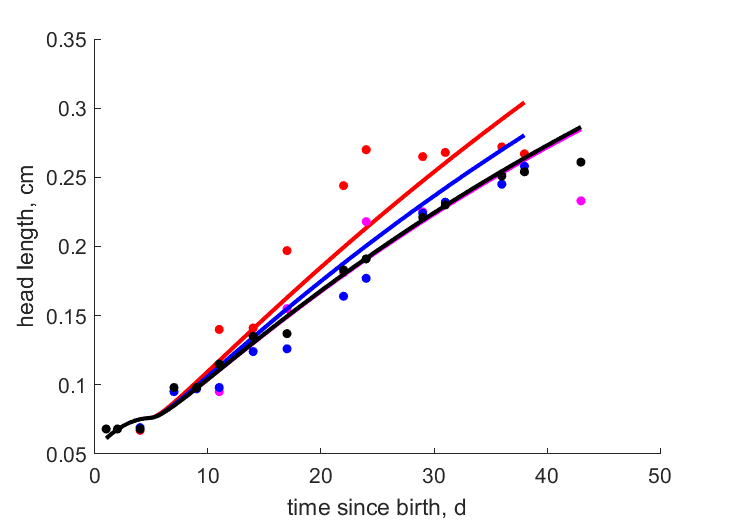 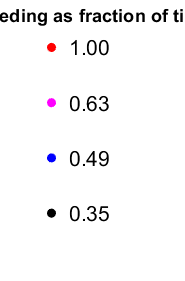 | time since birth | head length | (0.1094) | KlagGerg2024 |
| tL_fB2 |   | time since birth | head length | (0.06392) | KlagGerg2024 |
| tL_fB3 |   | time since birth | head length | (0.09316) | KlagGerg2024 |
| tL_fB4 |   | time since birth | head length | (0.03964) | KlagGerg2024 |
| tWw_fB1 |  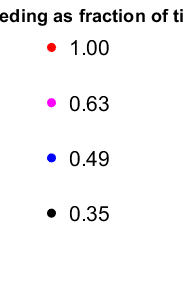 | time since birth | wet weight | (0.3046) | KlagGerg2024 |
| tWw_fB2 |   | time since birth | wet weight | (0.2713) | KlagGerg2024 |
| tWw_fB3 |   | time since birth | wet weight | (0.2134) | KlagGerg2024 |
| tWw_fB4 |   | time since birth | wet weight | (0.1756) | KlagGerg2024 |
| tN_fB1 | 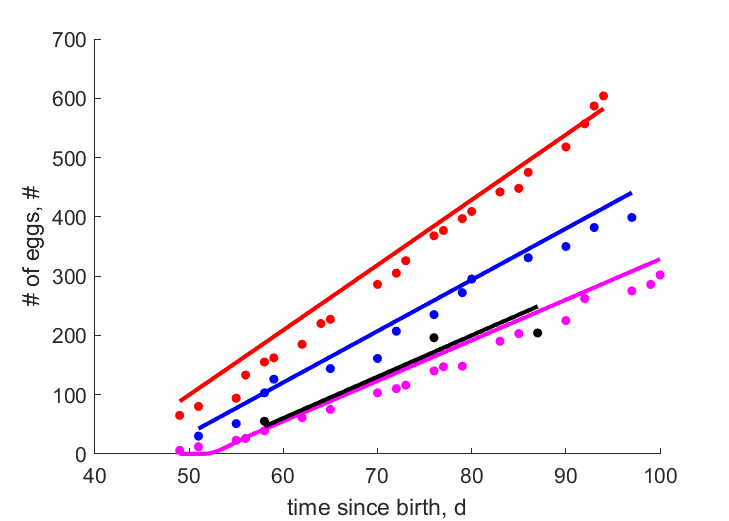 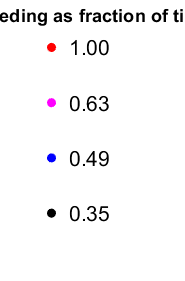 | time since birth | # of eggs | (0.08543) | KlagGerg2024 |
| tN_fB2 |   | time since birth | # of eggs | (0.1434) | KlagGerg2024 |
| tN_fB3 |   | time since birth | # of eggs | (0.09251) | KlagGerg2024 |
| tN_fB4 |   | time since birth | # of eggs | (0.1703) | KlagGerg2024 |
| Tab |  | temperature | age at birth | (0.3094) | KlagGerg2024 |
| Tr_embryo | 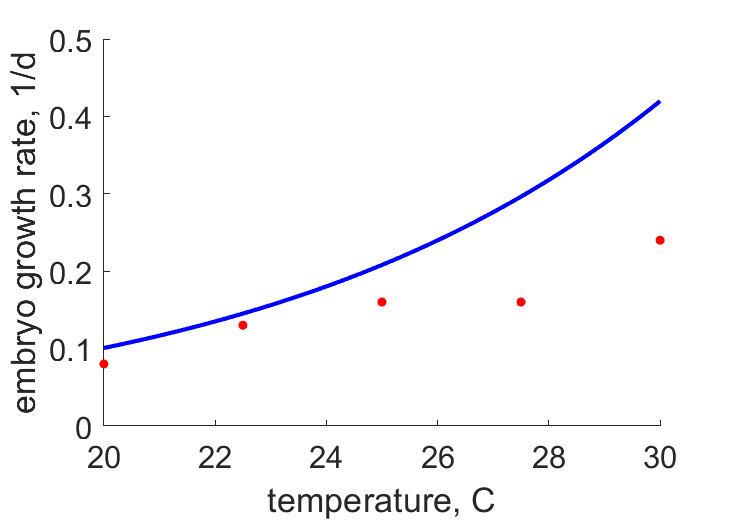 | temperature | embryo growth rate | (0.5192) | Kari1961 |
| Tr_larva |  | temperature | larva growth rate | (0.1965) | Kari1961 |
| Ttins |  | temperature | duration of larva | (0.2353) | Kari1961 |
| tSN |  | time | nymphal survival rate | (0.01593) | MediRoss2022 |
Pseudo-data at Tref = 20°C
| Data | Generalised animal | Nezara viridula | Unit | Description |
|---|---|---|---|---|
| v | 0.02 | 0.01471 | cm/d | energy conductance |
| p_M | 18 | 463.9 | J/d.cm^3 | vol-spec som maint |
| k_J | 0.002 | 0.1082 | 1/d | maturity maint rate coefficient |
| k | 0.99 | 0.9857 | - | maintenance ratio |
| kap | 0.8 | 0.9391 | - | allocation fraction to soma |
| kap_G | 0.8 | 0.8417 | - | growth efficiency |
| kap_R | 0.95 | 0.95 | - | reproduction efficiency |
Discussion
- abp model also works well for this species
- Biological observations show that length at which stage transitions occur does not change much across different levels of food availability for many insect species.
- The selection of the mainenance ratio k=0.99 as pseudo-data, is based on the implied property of the model that when k=1, stage transitions occur at fixed structural length. This property aligns with observationsin D2
- First instar nymphs do not eat, they are modeled as non-feeding juvenile instead of embryo. This makes sbp model more general as not all insects have a non-feeding first instar.
Facts
- During the first instar the nymph does not feed (Ref: PaniMene1989, PaniOliv1998)
Acknowledgment
- Version 2024/01/18 of this entry was financially supported by Bayer.
Bibliography